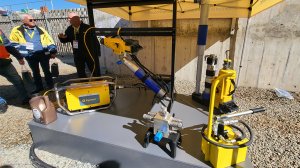Conventional mining operations have relied on pneumatic machines for years, but mining equipment supplier Epiroc is confident that its hydraulic hand-held rock drill (HRD) 100, is poised to replace current pneumatic models in the market, especially once its multistage pusher leg is made available to the market.
The HRD 100 finds extensive applications in conventional mining and tunnelling operations, particularly in support drilling and production drilling.
It excels at drilling and blasting operations required to develop and maintain mine faces, Epiroc business development manager South Africa for HRD David Baird says when speaking to Engineering News & Mining Weekly at the company’s customer day in June.
“With its multistage pusher leg, the HRD 100 offers versatility and adaptability to different mining environments,” he notes.
Initially, the pusher leg design comprised five different sizes, ranging from 0.9 m to 1.5 m, catering to various stoping heights and development ends. However, Baird says that a more streamlined approach was pursued with the HRD 100, leading to the development of a self-retracting, multistage pusher leg.
“This innovative design, achieved in partnership with a local supplier, is the first of its kind in the world,” he enthuses.
The multi-stage pusher leg is currently undergoing rigorous testing, with successful trials having already been documented.
In the coming months, once the final trial results are obtained and any necessary adjustments are made, the HRD 100 will be ready for market release.
Further, an intelligent power pack is incorporated into the HRD 100’s pumping system, which monitors and adjusts the pressures and flows required by the rock drill.
“When the operator is drilling, the pressure and flow naturally increase, using the 10 kW of power necessary to operate the hydraulic pump effectively. However, when the operator switches off the percussion function on the drill, the power pack recognises this and enters standby mode, consuming only 1 kW of electrical supply,” Baird explains.
Should the operator leave the drill unattended, the power pack automatically shuts off, thereby consuming no electrical energy.
The HRD 100 is hydraulic, and not hydropower-based, which Baird says “eliminates the need for high-pressure water systems”.
The only water requirement is a 12-litre-per-minute flow and between five and eight bars of water pressure supply. This minimal water use primarily serves the purpose of cooling the oil and generating the necessary thrust from the leg to achieve a one-metre a minute penetration rate.
The system will also soon incorporate a greater volume of local content, despite the rock drill and power pack currently being assembled in Sweden.
In this regard, Baird highlights that efforts are under way to increase the local content percentage to 100% by moving the assembly process to South Africa.
“This transition would require the support of customers, and plans are in place to expedite the process as much as possible,” he states.
Comparable to other rock-drill offerings in the market, Baird adds that Epiroc’s hydraulic rock drill “boasts significantly lower operational costs than alternate conventional drilling equipment”.
He explains that while the initial capital expenditure may be slightly higher to purchase the hydraulic rock drill, the long-term cost reduction achieved through low energy consumption and increased production efficiency “makes it a compelling choice”.
Moreover, the extended life span of tools, such as drill steels and bits, adds further value to the HRD 100, which also offers productivity gains through delivering “excellent penetration rates”, comparable to other rock drills on the market.
This means that mining operations can achieve their drilling targets effectively while experiencing the advantages of a hydraulic system, Baird says, highlighting that HRD 100's precision and power “enable operators to accomplish their tasks more efficiently, ultimately leading to increased production levels”.
“The innovative features, cost-effectiveness, and focus on operator safety make it a standout choice for conventional mining and tunnelling operations.
By embracing hydraulic technology and using intelligent power management, the HRD 100 is poised to transform the way mining operations are conducted,” Baird concludes.
Edited by: Donna Slater
Features Deputy Editor and Chief Photographer
EMAIL THIS ARTICLE SAVE THIS ARTICLE
ARTICLE ENQUIRY
To subscribe email subscriptions@creamermedia.co.za or click here
To advertise email advertising@creamermedia.co.za or click here












